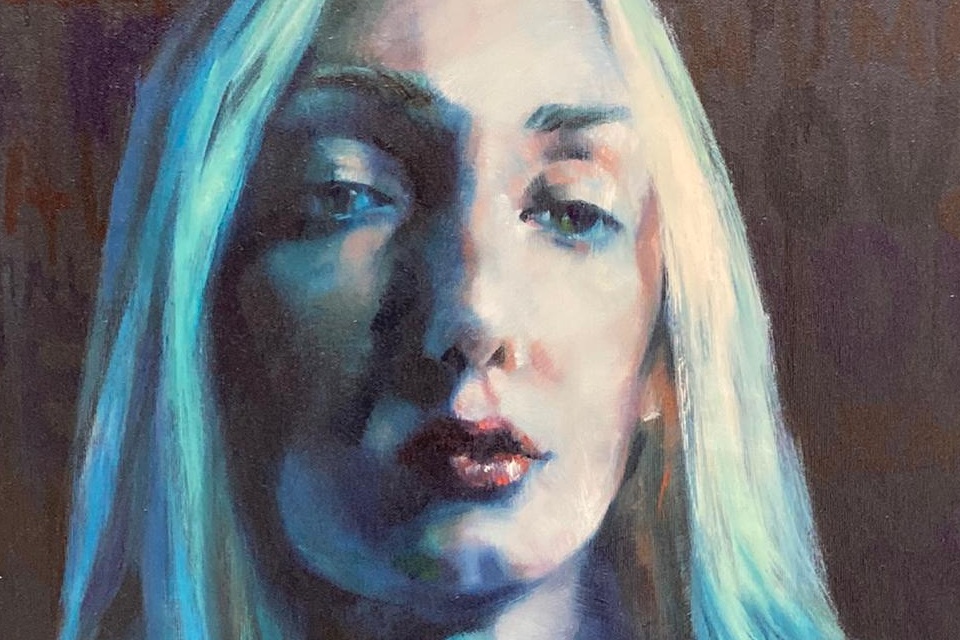
A Hidden Gem in the City – The 2021 Every Woman Biennial
author: BECCA MAGUIRE, ART WRITER AT GALLERIA MEERA
The Every Woman Biennial is the world’s largest female and non-binary art festival. The show runs in two major cities simultaneously – London (June 12 – July 9) and New York (June 24 – July 3) 2021.
The festival provides a platform for female and non-binary artists to gain exposure. It also brings together both established and emerging artists. In this article, Galleria Meera art writer Becca Maguire showcases her favourite pieces from the show and reviews the exhibition experience.
An unexpected oasis in bustling Peckham Rye – I came across an eclectic mix of works ranging from sculpture, to video, to painting. The Every Woman Biennial exhibition at London’s Copeland Gallery definitely inspired responses of awe and surprise, due to its multimedia nature, and, most obviously, the unique curation of the works. The paintings and tapestries were displayed on the walls above and below each other, enabling the eye to dart from one to another, in order to best appreciate the variety.
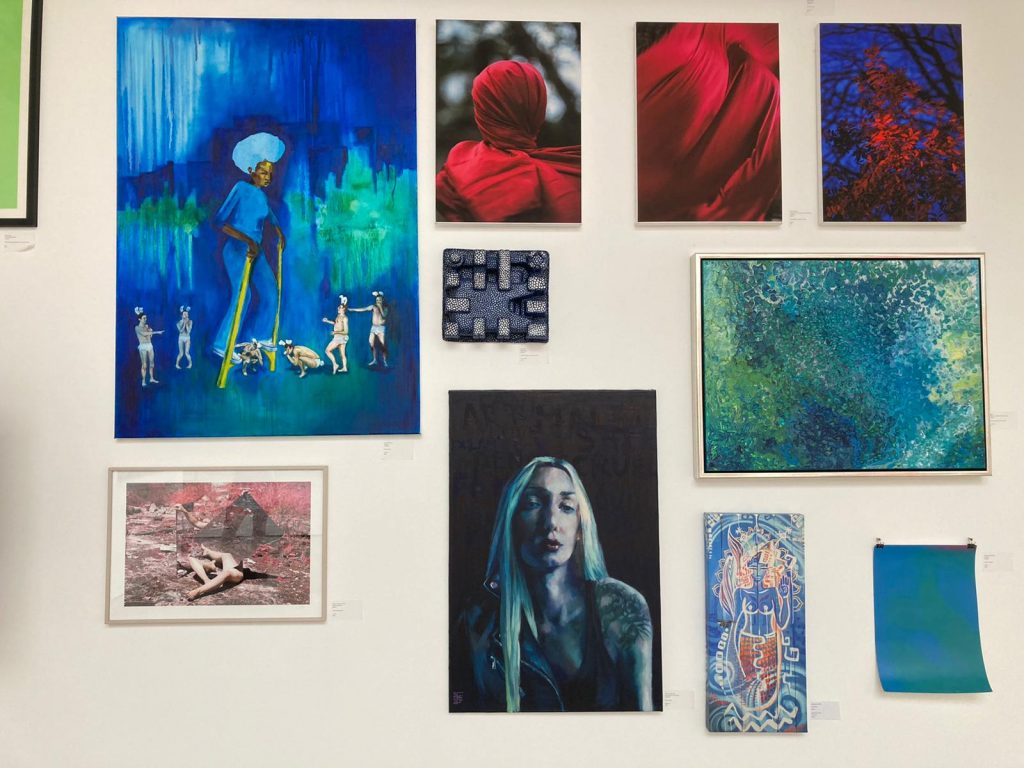
A few works stood out to me. Kateryna Bortsova’s oil painting entitled Self-portrait/ Self isolation (2020) featured alongside other paintings and photographs, both abstract and realistic, sharing a common theme of a blue and green colour palette. This was sharply interrupted by the flashes of red in the photos of cloth and blossom, providing a complementary shade to the green tones.
For me, Kateryna’s work is a manifestation of the thoughts and feelings that we all experienced during lockdown, where a gloomy outlook became the norm. I particularly appreciated the combination of visual and verbal, with words including ‘cruel’ and ‘love’ featured in the dark background. One visitor to the gallery commented on the work as an ‘honest portrayal of quarantine, with an interesting use of lighting and underpainting with text’. Others appreciated the use of indigo to create a sinister feel whilst also accepting it as just a ‘moment of lighting and being’. This captures the nature of Kateryna’s oeuvre which seeks to highlight and capture the idea of human development and self-improvement, whilst also remaining intensely autobiographical.
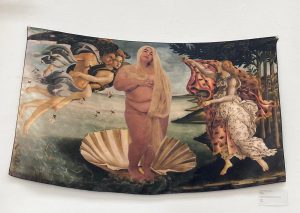 Another work which particularly appealed to me was Yasmeen Fathima Thantrey’s Birth of (2020), a digitally edited photograph printed on silk. Whilst studying art history, I regularly viewed and considered Botticelli’s The Birth of Venus (1484-6) as an integral component of the artistic canon. I see Thantrey’s parody as a refreshing revisioning of the iconic 15th century painting. Botticelli presents a slender, idealised Venus occupying the shell. Her ivory skin paired with her presence in the enlarged shell perhaps suggests that here, Venus is actually the pearl. The goddess is classically rendered, indicative of Renaissance idealism, highlighting that she reflects canonical ideals.
Another work which particularly appealed to me was Yasmeen Fathima Thantrey’s Birth of (2020), a digitally edited photograph printed on silk. Whilst studying art history, I regularly viewed and considered Botticelli’s The Birth of Venus (1484-6) as an integral component of the artistic canon. I see Thantrey’s parody as a refreshing revisioning of the iconic 15th century painting. Botticelli presents a slender, idealised Venus occupying the shell. Her ivory skin paired with her presence in the enlarged shell perhaps suggests that here, Venus is actually the pearl. The goddess is classically rendered, indicative of Renaissance idealism, highlighting that she reflects canonical ideals.
Thantrey updates this piece, in keeping with our 21st century society that strives, and must continue to strive, to embrace bodies, genders, and races of all types. Venus is here replaced by Thantrey herself, a South Asian woman, posing with a long blonde wig and covering her breasts and genitalia. I admire how thought-provoking the work is, forcing us to question ingrained stereotypes of Eurocentric beauty, diet culture, social media photoshop, and fat shaming. By placing herself in the shell, she becomes the pearl, the icon of beauty, and even paves the way for others to do the same.
By leaving the title without a name, the viewer could potentially visualise themselves in the pearl on a pedestal, and therefore embrace their body, imperfections and all. In an age of plastic surgery and photo editing, Thantrey allows us to view this celebrated Renaissance work through a modern lens, shedding much-needed light on female bodies, beauty, and the art world generally. Overall, I feel this work perfectly illustrates the message of the Every Woman Biennial, capturing a female artist celebrating inclusivity with a modern twist.
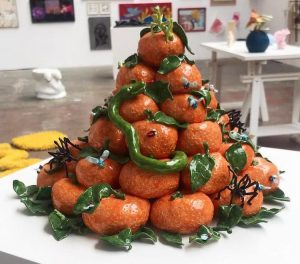 I also enjoyed Katy Stubbs’ porcelain and glaze sculpture, We Have Been Waiting (2021). Displayed in the middle of the room, the bright colour of the oranges immediately caught my eye, but it was only upon closer inspection that I saw the multitude of flies, spiders, and even a snake situated on and around the pile of fruits. This fairly small work (in comparison to the large tapestries and paintings elsewhere) brought to mind motifs I have previously considered, including the Biblical story of Adam and Eve and the notion of a memento mori.
I also enjoyed Katy Stubbs’ porcelain and glaze sculpture, We Have Been Waiting (2021). Displayed in the middle of the room, the bright colour of the oranges immediately caught my eye, but it was only upon closer inspection that I saw the multitude of flies, spiders, and even a snake situated on and around the pile of fruits. This fairly small work (in comparison to the large tapestries and paintings elsewhere) brought to mind motifs I have previously considered, including the Biblical story of Adam and Eve and the notion of a memento mori.
For me, the green snake slithering around and within the pile of oranges provoked thought of the forbidden fruit which Eve ate, leading to The Fall and human damnation. The fruits glisten under the studio lighting, tempting the viewer in, similar to the events which occurred in the Garden of Eden. However, unlike the apple which was bitten, these oranges remain forbidden fruits as visitors must of course not touch the artwork. Moreover, the ripe fruits serve to remind us of the cyclical nature of life and death. Indeed, these oranges will not maintain their bright exterior and ripe flesh but will soon rot and become food for insects, which are shown greedily waiting, standing on the pile. Similar to 16th and 17th century Vanitas paintings which usually incorporate a flower and skull, here the oranges, like humanity, will inevitably die and degrade.
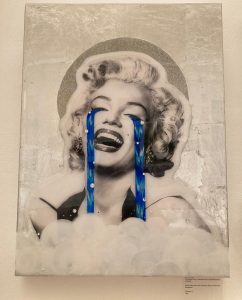 Finally, I enjoyed Briana Chapin’s mixed media work entitled Everything Is Fine – Diamonds are a Girl’s Best Friend (2021). This monochromatic work inevitably caught my eye as it depicts the female icon, Marilyn Monroe. Presented with her characteristic smile, she stares at the viewer; however, from her eyes stream bright blue tears, so large that they appear like two rivers encrusted with rhinestones. She is pitted against a silver sparkling circle, which forms a halo above her head. For me, this work was incredibly poignant and upsetting to view, as it is an accurate, honest work of Marilyn. Unlike the pictures of her smiling and laughing which dominate history, here we see the reality.
Finally, I enjoyed Briana Chapin’s mixed media work entitled Everything Is Fine – Diamonds are a Girl’s Best Friend (2021). This monochromatic work inevitably caught my eye as it depicts the female icon, Marilyn Monroe. Presented with her characteristic smile, she stares at the viewer; however, from her eyes stream bright blue tears, so large that they appear like two rivers encrusted with rhinestones. She is pitted against a silver sparkling circle, which forms a halo above her head. For me, this work was incredibly poignant and upsetting to view, as it is an accurate, honest work of Marilyn. Unlike the pictures of her smiling and laughing which dominate history, here we see the reality.
Monroe was a fake persona projected to the public. In an exhibition which celebrates empowered females, Marilyn presents a striking contrast as someone who was taken advantage of and suffered, leading to a premature death as a victim of the façade of glamour and fame. Despite being one of the most famous women in history, we were fed lies by Hollywood and did not truly know her or even her real name. The blue stream of tears which advances from the picture plane and captures the viewer’s attention therefore reveals the truth of this female icon, a woman who was victimised to the extreme.
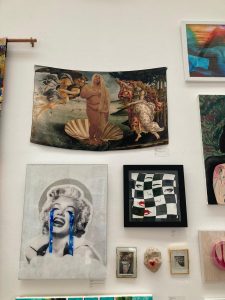
In terms of curating, this work was displayed directly underneath Thantrey’s Birth of which was especially poignant as it highlighted the need for the authenticity and honesty that Thantrey defiantly exhibits.
Overall, the Every Woman Biennial was a fantastic experience, celebrating diversity and female empowerment. I came away with plenty to consider, which, in my view, is the mark of a successful exhibition. After such a long time locked down at home, what a wonderful way to spend an afternoon!
To learn more about Kateryna, visit: https://www.galleriameera.com/kateryna-bortsova-artist-bio/
To view and enquire about Kateryna’s works available for purchase, visit our Virtual Gallery here: https://www.galleriameera.com/gallery/

